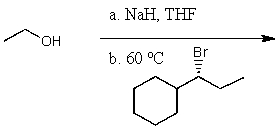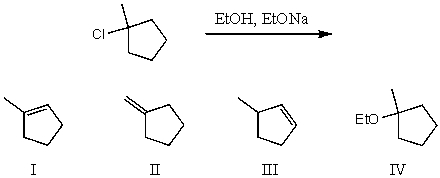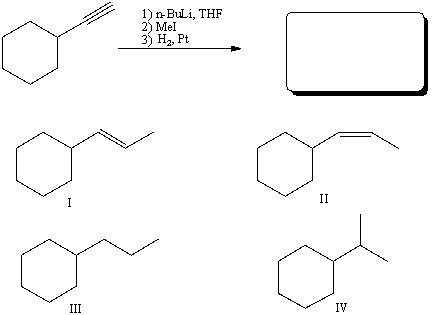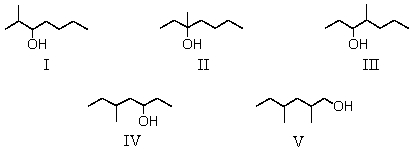A) I
B) II
C) III
D) IV
E) V
Correct Answer

verified
Correct Answer
verified
Multiple Choice
Predict the major product(s) for the following reaction sequence. 
A) A mixture of ![]() and
and![]()
B) ![]()
C) ![]()
D) ![]()
E) A mixture of two of these choices.
Correct Answer

verified
Correct Answer
verified
Multiple Choice
Which of the following methods could be used to synthesize 4,4-dimethyl-2-hexyne?
A) ![]()
B) ![]()
C) ![]()
D) More than one of these choices.
E) None of these choices.
Correct Answer

verified
Correct Answer
verified
Multiple Choice
By analyzing the starting material and the product(s) ,the following reaction is an example of what type of mechanism? 
A) SN1
B) SN2
C) E1
D) E2
E) None of these choices.
Correct Answer

verified
Correct Answer
verified
Multiple Choice
When 0.10 mol of ICH2CH2CH2CH2Cl reacts with 0.10 mol of NaOCH3 in CH3OH at 40 C,the major product is:
A) CH3OCH2CH2CH2CH2Cl
B) CH3OCH2CH2CH2CH2I
C) CH3OCH2CH2CH2CH2OCH3
D) CH2=CHCH2CH2Cl
E) CH2=CHCH2CH2I
Correct Answer

verified
Correct Answer
verified
Multiple Choice
What would be the major product(s) of the following reaction? 
A) I
B) II and III
C) II,III,and IV
D) III and IV
E) None of these choices.
Correct Answer

verified
Correct Answer
verified
Multiple Choice
Elimination reactions are favored over nucleophilic substitution reactions
A) at high temperatures.
B) when tert-butoxide ion is used.
C) when 3 alkyl halides are used as substrates.
D) when nucleophiles are used which are strong bases and the substrate is a 2 alkyl halide.
E) in all of these cases.
Correct Answer

verified
Correct Answer
verified
Multiple Choice
What are the major product(s) formed when trans-1-bromo-2-methylcyclohexane reacts with sodium isopropoxide in isopropanol? 
A) I
B) II
C) I and II
D) III
E) III and IV
Correct Answer

verified
Correct Answer
verified
Multiple Choice
Which of the following reactions would yield 3,3-dimethyl-1-butene in a reasonable percentage yield (i.e.,greater than 50%) ?
A) ![]()
B) ![]()
C) ![]()
D) All of these choices.
E) Only two of these choices.
Correct Answer

verified
Correct Answer
verified
Multiple Choice
Which alkyl halide,when treated with sodium ethoxide in ethanol,would afford a product mixture consisting of more than one elimination product?
A) 1-bromo-3,3-dimethylpentane
B) 1-bromo-2,3-dimethylpentane
C) 2-bromo-3,4-dimethylpentane
D) 2-bromo-3,3-dimethylpentane
E) None of these choices would yield more than one elimination product.
Correct Answer

verified
Correct Answer
verified
Multiple Choice
Rearrangements are likely to occur in which of the following reaction types?
A) SN1 reactions
B) SN2 reactions
C) E1 reactions
D) E2 reactions
E) Both SN1 and E1 reactions
Correct Answer

verified
Correct Answer
verified
Multiple Choice
What would be the major product(s) of the following reaction? 
A) I and III
B) I and II
C) II and III
D) IV
E) None of these choices.
Correct Answer

verified
Correct Answer
verified
Multiple Choice
Which reaction would not result in alkylation of the acetylide anion as the major products?
A) ![]()
B) ![]()
C) ![]()
D) ![]()
E) None of these choices.
Correct Answer

verified
Correct Answer
verified
Multiple Choice
Which statement is/are true about acetylide anions?
A) The alkylated product is poor with secondary alkyl halides.
B) Primary alkyl halides are best suited for alkylation.
C) In the presence of tertiary alkyl halides,the acetylide anion acts as base to give an elimination product.
D) Only two of these statements are true.
E) All of the statements are true.
Correct Answer

verified
Correct Answer
verified
Multiple Choice
Which of these compounds would give the largest E2/SN2 product ratio on reaction with sodium ethoxide in ethanol at 55°C?
A) ![]()
B) ![]()
C) ![]()
D) ![]()
E) ![]()
Correct Answer

verified
Correct Answer
verified
Multiple Choice
If 0.10 mol of HSCH2CH2OH reacts at 25 C,sequentially,with 0.20 mol of NaH,0.10 mol of CH3CH2Br followed by the addition of H2O,which is the major product?
A) HSCH2CH2OCH2CH3
B) CH3CH2SCH2CH2OH
C) CH3CH2SCH2CH2OCH2CH3
D) CH2=CH2
E) CH3CH3
Correct Answer

verified
Correct Answer
verified
Multiple Choice
Which of the following compounds could be produced from the following reaction sequence? 
A) I
B) II
C) III
D) IV
E) mixture of III and IV
Correct Answer

verified
Correct Answer
verified
Multiple Choice
Which one of the following alcohols would dehydrate most rapidly when treated with sulfuric acid? 
A) I
B) II
C) III
D) IV
E) V
Correct Answer

verified
Correct Answer
verified
Multiple Choice
The correct IUPAC name for the following compound is: 
A) (E) -2-Bromo-3-chloro-5-methyl-2-hexene
B) (E) -2-Bromo-3-chloro-5-methyl-3-hexene
C) (Z) -2-Bromo-3-chloro-5-methyl-3-hexene
D) (Z) -2-Bromo-3-chloro-5-methyl-2-hexene
E) (E) -2-Methyl-5-bromo-4-chloro-4-hexene
Correct Answer

verified
Correct Answer
verified
Multiple Choice
What are the major product(s) formed when cis-1-bromo-2-methylcyclohexane reacts with sodium isopropoxide in isopropanol? 
A) I
B) II
C) I and II
D) III
E) III and IV
Correct Answer

verified
Correct Answer
verified
Showing 121 - 140 of 220
Related Exams